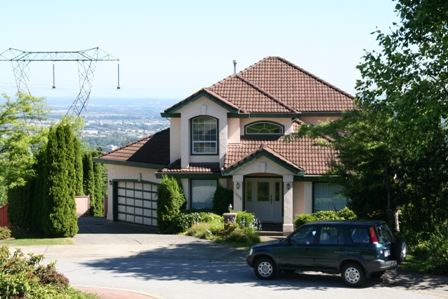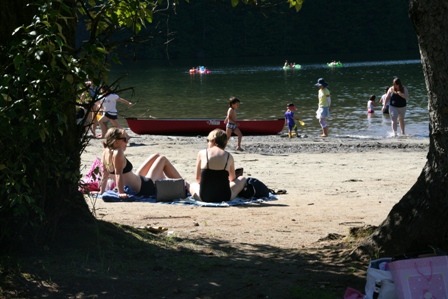|
|
|
|
|
History of Coquitlam (CQL), Greater Vancouver |
|
20090713 |
|
 |
|
|
|
When we first came to Greater Vancouver we got settled in Coquitlam for three years. Needless to say, we just fell in love with this place. It's so close to nature: the beautiful lake Buntzen, lake Sasamat where our kids enjoy swimming in the summertime, and, of course, Belcarra beach with its wonderful park where once in a while we'd come for a barbecue. Later we moved to Burnaby, but still it's on the border with Coquitlam. Thus we keep going places in Coquitlam.
Native people named the Kwayquitlam (or Quay-quit-lam) after a small fresh-water sockeye salmon. Coquitlam's development begins with the gold rush of 1858. Col. R. C. Moody arrived with 400 Royal Engineers, narrowly decided against founding the provincial capital at Mary Hill, and moved downriver to New Westminster. That winter the Fraser froze, cutting off supply ships. To render the capital more defensible against any American aggression, in the summer of 1859 Moody built the North Road, which ran unswervingly dead north from New Westminster to a salt-water port at the head of the InIet, since called Port Moody. The north end of the road was exceedingly steep, and in 1884 a gentler cutoff, Clarke Road, was built. Moody and other Royal Engineers, along with some early settlers, then claimed the land adjoining North Road and in the bottoms along the Fraser. In 1862, to link up their good Fraser farming lands, the Engineers built Pitt River Road, which today includes Brunette, Cape Horn, and Mathewson avenues and Pitt River Road. In 1863 the Engineers were recalled to England; the officers said out and returned home, leaving many of the enlisted men as settlers.

In 1886 the CPR reached Port Moody, with a branch line from Westminster Junction, at the Coquitlam River, to New Westminster. These rail lines, with North and Clarke roads, established the present ring of traffic corridors around the Coquitlam plateau, and created a centre at Westminster Junction. In 1890 the City of New Westminster brought water from Coquitlam Lake down Pipeline and Pitt River roads; the water also served Westminster Junction. In 1891 the present area of Coquitlam and Port Coquitlam was incorporated as the District Municipality of Coquitlam. Three population clusters developed. The principal one was Westminster Junction, which became Port Coquitlam, the second Millside and the third Burquitlam. Burquitlam was composed of the residents along, or with access to, North Road. Millside was the railway station at the Ross, McLaren Sawmills, which in 1903 became the Fraser River Sawmills. A substantial portion of the mill workers were Chinese, Japanese and East Indians, and until the 1930s Coquitlam had Vancouver's largest East Indian settlement. Another ethnic group were the many French Canadians, particularly lumber workers, who signed up with the company and came West after a recruitment trip to the East by company employee Theodore Theroux and New Westminster priest Father O'Boyle in 1909.
Vancouver first hydroelectric power, replacing that from steam generators, was provided by the creation of Buntzen Lake in 1905, after a tunnel was drilled under Eagle Mountain from Coquitlam Lake for water supply. And in that year the CPR, while expropriating lands for its freight marshalling yards, talked the residents of Westminster Junction into believing that the yards, together with the cargo capacity of the Fraser and Pitt waterfront, and the imminent opening of the Panama Canal (1914), would turn their settlement into an industrial complex greater than Vancouver. So, not wanting to subsidize with their expected new wealth the large undeveloped portions of the District, they arranged with the province to secede. In 1913 the City of Port Coquitlam was incorporated. Coquitlam was thus left with most of the land and little development.
Until World War II, Coquitlam population grew gradually and essentially in conformity with its economic base: people worked in the municipality or nearby. After the war this changed. With plentiful land, easy subdivision with minimal servicing and good automobile transport, Coquitlam commenced an explosive residential growth. Just over 16,000 residents in 1951 more than quadrupled to 65,000 in 1975. The era of suburban sprawl was signalled in 1951 by the completion of the Lougheed Highway. Then came those great cultural forces of the 1950s, the supermarkets and shopping centres. New governmental and community buildings were concentrated on Poirier St. There was a boom in organized municipal recreation for youngsters, and a paucity of community consciousness among adults. The only industry that developed in step with this growth was the quarrying of gravel. In 1971 the province, recognizing the municipality's deficient industrial base, forced Fraser Mills to re-unite again with the District of Coquitlam. Of the 3 quadrants remaining as Coquitlam, the northwest and northeast are still semi-rural and largely empty, while the plateau in the south-west is approaching its residential capacity. Now the population of Coquitlam is more than 150 thousand people.

In October 2004, the Evergreen light rail transit line was approved in principle by the TransLink Board. This line will have 12 stations over 11 kilometres starting from Lougheed Town Centre up to the Coquitlam Center via North and Clarke Roads, linking neighbourhoods in Coquitlam, Port Moody and Burnaby and connecting with SkyTrain, West Coast Express and TransLink buses. Design is just getting underway on this new line.
One day late fall I was walking around Coquitlam Centre. All of a blue I discovered a cozy cafe on the small plaza at Barnet and Lansdowne not far from the Coquitlam Town Centre. Its name is Zia's Deli & Cafe and the owners serve wonderful Italian and Mediterranean cuisine like delicious and unique sandwiches, soups, some Mediterranean pickles, and of course spicy pesto. If you ask them they could treat you with some of their specials: forgotten recipes of Italian dishes. You don't believe me, just go and check it out. Their address is: 2773 Barnet Hwy, and phone number is: (604) 944-2747 .
Mitch Grigori
|
|
|
|

